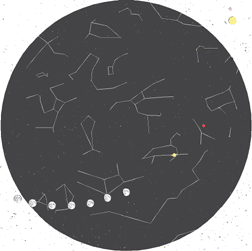Bright Lights Near and Far
In space, distance is all relative
Darkness finds Mercury clinging to the northeast horizon, but the waning planet is dimmer than a week ago and sets fast in the northwest at 9:30.
As Mercury sets, Mars is high in the west. Adrift in the dim stars of Cancer, the planet stands out as a dull orange blob.
There’s no mistaking Saturn, some 20 degrees behind Mars. Its distinct golden glow outshines everything in the evening sky except the moon. A couple degrees to the west shines Regulus, the sparkling heart of Leo the lion.
Shining 350 times brighter than our sun, Regulus is a mis-shaped giant. Astronomers have long suspected something odd about the star, but only recently has the orbiting Chandra Observatory revealed that Regulus spins more than 100 times faster than our sun, creating a huge bulge at the star’s equator. Spinning just a little faster, Regulus would literally spin itself apart.
Far to the east, the waxing gibbous moon rises after nightfall at week’s end. Friday the moon passes less than three degrees below bluish-white Spica, the chaff of wheat clutched in Virgo’s outstretched hand.
The 16th-brightest star, Spica is a beast, as it is 262 light years away yet shines 2,300 times brighter than the sun.
Monday’s full, Flower Moon rises in the southeast as the sun sets in the northwest. Two nights later, the now-waning gibbous moon trails three degrees behind the blood-red heart of Scorpius.
More than 600 light years away, the red-giant Antares is not only 9,000 times brighter than our sun, it is so much larger that it would easily consumer Earth in its mass.
Tidelog®
Illustration: © Copyright 1925 M.C. Escher/Cordon Art-Baarn-Holland; Graphics: © Copyright 2007 Pacific Publishers. Reprinted by permission from the Tidelog graphic almanac. Bound copies of the annual Tidelog for Chesapeake Bay are $14.95 ppd. from Pacific Publishers, Box 480, Bolinas, CA 94924. Phone 415-868-2909. Weather affects tides. This information is believed to be reliable but no guarantee of accuracy is made by Bay Weekly or Pacific Publishers. The actual layout of Tidelog differs from that used in Bay Weekly. Tidelog graphics are repositioned to reflect Bay Weekly’s distribution cycle.Tides are based on National Oceanic and Atmospheric Administration and are positioned to coincide with high and low tides of Tidelog.
